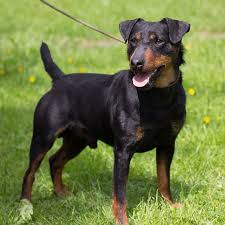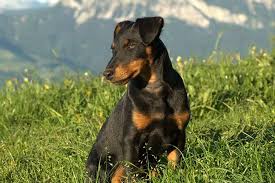The Jagdterrier, also known as the German Hunting Terrier, is a breed of dog that hails from Germany. Developed in the early 20th century, this compact and versatile working dog was specifically bred for hunting purposes. With its remarkable hunting skills, tenacious nature, and strong character, the Jagdterrier has gained popularity not only as a hunting companion but also as a loyal and loving family pet.
Appearance-wise, the Jagdterrier is a medium-sized dog with a sturdy and well-muscled build. Its coat is short, dense, and weather-resistant, allowing it to withstand various terrains and climates. The breed’s most common color is black and tan, but it can also be found in solid black or dark brown. The Jagdterrier has a distinctive square-shaped head, a strong jaw, and expressive, dark eyes that exude intelligence and alertness.
One of the standout qualities of the Jagdterrier is its unwavering determination and fearlessness when it comes to hunting. Originally bred to assist in hunting foxes, boars, and other game, this breed possesses a keen sense of smell and remarkable tracking abilities. Its small size and agile physique make it well-suited for pursuing game in dense forests and challenging terrains where larger dogs might struggle.
Beyond hunting, the Jagdterrier’s versatility extends to various other roles. It excels in tasks such as tracking, search and rescue, and even participating in various dog sports. This breed’s agility, intelligence, and strong prey drive make it highly trainable, provided it receives proper socialization, consistent training, and sufficient mental and physical stimulation.
While the Jagdterrier’s hunting instincts run deep, it also possesses a gentle and affectionate side, making it a wonderful addition to the family. With its strong bond to its human companions, the Jagdterrier is known to be a loyal and protective breed, always ready to defend its loved ones. However, it is important to note that due to its strong prey drive, early socialization is crucial to ensure that it gets along well with other animals and pets in the household.
As an active breed, the Jagdterrier thrives on physical exercise and mental stimulation. Regular long walks, jogs, or hikes in nature are essential to keep this breed physically and mentally balanced. Interactive toys, puzzle games, and obedience training sessions are also great ways to engage their agile minds. Without proper exercise and mental stimulation, the Jagdterrier may become bored and exhibit destructive behavior.
In terms of health, the Jagdterrier is generally a robust and healthy breed with few breed-specific issues. Regular veterinary check-ups, a balanced diet, and a good exercise routine are essential to maintain their overall well-being.
However, the Jagdterrier is a remarkable breed with a rich heritage in hunting. Its versatility, tenacity, and intelligence make it a superb working dog, while its loyalty and affection make it a beloved family companion. Whether you’re an avid hunter looking for a dedicated hunting partner or an active family in search of an energetic and loving pet, the Jagdterrier may just be the perfect fit for you.
Read Also: Major Constraints to Satisfying Increasing Demand for Fish
History and Origin of JagdTerrier Dogs

The Jagdterrier, as its name suggests, originates from Germany and has a relatively short but fascinating history. The breed was developed in the early 20th century with the goal of creating a versatile hunting dog that could excel in various terrains and game types.
The development of the Jagdterrier can be traced back to the late 19th century when German breeders sought to create a proficient hunting dog specifically for hunting quarry such as foxes, badgers, and other small game. They aimed to develop a breed that possessed exceptional hunting skills, including tracking, retrieving, and dispatching game.
The breed’s foundation is believed to involve several different terrier breeds, including the Fox Terrier, Welsh Terrier, and Black and Tan Terrier. By selectively breeding these terriers, breeders aimed to create a dog that had the desired characteristics for hunting purposes.
The German Hunting Terrier Club (Deutscher Jagdterrier-Club) was founded in 1926, and it played a crucial role in further developing and standardizing the breed. The club established a breed standard and focused on maintaining and improving the Jagdterrier’s hunting abilities while ensuring it retained its versatility and tenacity.
During World War II, the Jagdterrier faced some challenges due to the war’s impact on dog breeding programs in Germany. However, dedicated breeders managed to preserve the breed by carefully selecting breeding stock and ensuring the continuation of the breed’s desirable traits.
After the war, the Jagdterrier gained recognition beyond Germany’s borders and started to gain popularity in other countries as a skilled hunting dog. It was officially recognized by the Federation Cynologique Internationale (FCI) in 1954, which further solidified its status as an established breed.
Today, the Jagdterrier continues to be valued as a working dog and hunting companion. Its versatility, determination, and tenacity have made it a popular choice among hunters around the world. While it remains primarily a hunting breed, it has also found a place in households as a loyal and active family companion.
The breed’s history and origin highlight its purposeful development as a specialized hunting dog. The dedication of German breeders to create a versatile and skilled hunting companion has resulted in the creation of the Jagdterrier, a breed that continues to demonstrate its hunting prowess while also proving to be a loving and loyal companion.
Health Issues and Lifespan of JagdTerrier Dogs
The Jagdterrier is generally a healthy and robust breed with no significant breed-specific health issues. However, like all dogs, they can still be prone to certain health conditions. Responsible breeders strive to minimize the occurrence of these conditions through careful breeding practices, health screenings, and genetic testing.
Here are a few health issues that may affect the Jagdterrier:
Hip Dysplasia: This is a common condition in many dog breeds. It occurs when the hip joint develops abnormally, leading to discomfort and potentially causing lameness. Responsible breeders will often screen their breeding dogs for hip dysplasia to reduce the risk of passing it on to offspring.
Patellar Luxation: This condition involves the dislocation of the kneecap, which can cause lameness and discomfort. It can range from mild to severe and may require veterinary intervention in severe cases.
Eye Problems: Some Jagdterriers may be prone to certain eye issues such as cataracts, progressive retinal atrophy (PRA), and lens luxation. Regular eye examinations by a veterinarian can help detect and manage these conditions.
Ear Infections: Like many dogs with floppy ears, Jagdterriers can be susceptible to ear infections. It is essential to regularly clean and check their ears for any signs of infection, such as redness, swelling, or discharge.
Dental Issues: Dental hygiene is important for all dogs, including Jagdterriers. They can be prone to dental problems such as periodontal disease and tooth decay. Regular dental care, including brushing their teeth and providing appropriate chew toys, can help maintain their oral health.
The lifespan of a Jagdterrier is typically between 12 to 14 years, although individual dogs may vary. With proper care, nutrition, regular exercise, and routine veterinary check-ups, Jagdterriers can lead healthy and fulfilling lives.
It is crucial for potential owners to work with reputable breeders who prioritize the health and well-being of their dogs. Additionally, providing a balanced diet, regular exercise, and preventive healthcare measures such as vaccinations and parasite control will contribute to a longer and healthier life for your Jagdterrier.
Read Also: Common Rabbit Diseases and How to Cure them
JagdTerrier Dog Breed Complete Grooming and Care Guide

Grooming and care are essential aspects of keeping your Jagdterrier healthy, comfortable, and looking their best.
Here is a comprehensive guide to grooming and caring for your Jagdterrier:
Coat Care: The Jagdterrier has a short, dense, and weather-resistant coat that requires minimal maintenance. Regular brushing with a soft-bristle brush or a grooming mitt helps to remove loose hair, dirt, and debris. Bathe your Jagdterrier only when necessary using a mild dog shampoo to avoid stripping their coat of natural oils. Ensure thorough drying after bathing to prevent skin issues.
Nail Care: Regular nail trimming is crucial to prevent overgrowth, discomfort, and potential injuries. Trim your Jagdterrier’s nails every few weeks or as needed using a dog nail clipper or grinder. Be cautious not to cut into the quick, which is the sensitive area inside the nail. If you are unsure, consult a veterinarian or professional groomer for guidance.
Dental Hygiene: Dental care is vital to maintain your Jagdterrier’s oral health. Brush their teeth regularly with a dog-specific toothbrush and toothpaste to prevent tartar buildup, gum disease, and bad breath. Providing dental chews or toys designed to promote dental health can also help keep their teeth clean.
Ear Cleaning: Jagdterriers, like many dogs with floppy ears, are prone to ear infections. Check their ears weekly for signs of redness, swelling, odor, or discharge. Clean their ears using a veterinarian-recommended ear cleanser and gently wipe the outer ear with a cotton ball or soft cloth. Avoid inserting anything deep into the ear canal to prevent injury.
Eye Care: Monitor your Jagdterrier’s eyes regularly for any signs of redness, discharge, or irritation. Keep the eye area clean and free from debris by gently wiping it with a damp cloth. If you notice any persistent issues, consult a veterinarian for proper evaluation and treatment.
Exercise and Mental Stimulation: The Jagdterrier is an active and energetic breed that requires regular exercise to stay physically and mentally fit. Provide daily opportunities for vigorous exercise, such as long walks, jogs, or interactive play sessions. Engage their minds with puzzle toys, obedience training, or participating in dog sports. A tired Jagdterrier is typically a well-behaved and contented one.
Socialization and Training: Proper socialization is essential for Jagdterriers to interact well with other animals, pets, and people. Expose them to various environments, sounds, and experiences from a young age to help them develop into well-rounded dogs. Consistent and positive training methods will help them learn obedience commands, good manners, and establish a strong bond with you.
Regular Veterinary Check-ups: Schedule regular veterinary check-ups to monitor your Jagdterrier’s overall health and address any concerns promptly. Vaccinations, parasite control, and preventive measures recommended by your veterinarian are crucial for their well-being.
Remember to show your Jagdterrier love, affection, and attention, as they thrive on human companionship. By providing them with proper grooming, care, and a stimulating environment, you will ensure a happy, healthy, and well-adjusted Jagdterrier for years to come.
Read Also: Efficient Solutions for Food Waste Disposal
